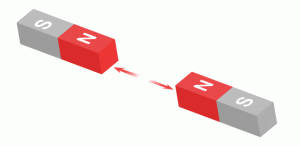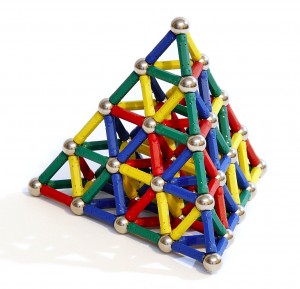It’s not just about getting behavior to change. The learner’s motivation for changing has a profound impact on the arc of future behavior. For example, getting a child to stop picking on someone to avoid punishment is not the same as teaching them empathy and the power of compassion.
When I teach humans or other animals, I want behavior change to be for the right reasons, whenever possible, so that the lessons can keep propagating forward over time, like ripples in a pond. That’s why I train dogs the way I do, and why I’m a huge fan of nonviolent communication (more about that in my How to Human class).
I like to think of two opposite forces that inspire behavior: attraction (I want) and repulsion (I don’t want). You can imagine these as physical forces, like gravity or what happens when you bring two magnets together in different ways. One way pulls them together in a very strong bond. Reverse that, and they’re pushing apart.

If you had one magnet and wanted to move the other one around without touching the second magnet, how would you do it? You can move the second magnet around very reliably if you use attraction. You can still move the magnet with repulsion, but pushing is less efficient than pulling, and sometimes shoves it in unpredictable directions.
Let’s go back to animals. By attraction, I mean that the animal is inspired to do the behavior. For example, there’s a smell across the room, so the dog walks over to investigate. The smell pulls him over. Or you ask the dog to sit and he does so because he has a history of getting treats for sitting. By sitting, he moves toward the opportunity to get a treat. It’s like the treat pulled him into sitting, so that’s why I call this attraction.
 Repulsion is another way to get behavior, by pushing the animals in a certain direction – in order to avoid something unwanted, an animal will change his behavior.
Repulsion is another way to get behavior, by pushing the animals in a certain direction – in order to avoid something unwanted, an animal will change his behavior.
For example, you tell the dog to sit and he does so because he has a history of getting a leash pop for not sitting. By sitting, he moves away from the threat of pain or pressure.
It’s as if the threat pushed him into sitting, so that’s why I call this repulsion. Similarly, a dog can be taught to heel because anywhere else – ahead, behind, off to the side – is not safe to walk. Even though you are pulling on the leash to give that correction, that’s not attraction — it’s still a force pushing the dog somewhere, it just happens to be toward you.
So in this model, dog training comes down to adding an attractive or repulsive force along with adjusting forces that already exist. The big debate in animal training today is really about whether to use attraction or repulsion.
Here at GrishaStewart.com, we use attraction, and this article helps explain why.
Repulsion and attraction are like pushing or pulling on a door – both options exert force and change what the door does. But unlike the door, your dog has emotions and memory, and attraction and repulsion are two very different experiences for the learner.
For example, there’s a technique in training called “alpha rolling” where the person pins the dog to the ground to enforce dominance. There are many ways to do it, from staring the dog down to physically flipping the dog over and holding them down.
That’s repulsion, pushing – you do something and the dog flips over in order to make it stop, or because there is physically no other choice. The dog is avoiding a negative consequence. Emotions probably range from annoyed to terrified.
Pro Tip: What isn’t widely known is that this kind of thing isn’t really what wolves do. It’s actually more of an “omega roll” because it is an offered behavior. The roll is not forced on them.
Using attraction, you can easily get your dog into the same position, if you wanted to. Watch the video below for more information.
Just pet your dog on the side of the neck. Pause every 5 seconds, gradually lowering your hands so he eventually flops over in order to get more petting. Is it necessary for leadership? I have no idea. But if a dog is happily flopping on his back in front of you, you can probably throw out any worries that your dog is trying to dominate you. And his day just got better, not worse, because of you. It’s win-win. More Please!
[vc_video link=”https://vimeo.com/126184989″]
Let’s put this in human terms for leadership. A manager can get employees’ cooperation via attraction or repulsion. Using attraction, the staff does what the manager wants because it’s rewarding. They enjoy the task itself, the social environment at work, or the result of doing the task.
Using repulsion, on the other hand, people would be doing the task because it’s the lesser of two evils. They get in trouble if they don’t do the task; to avoid trouble, they do their jobs.
Which kind of manager would you rather have? Which one would inspire higher quality work? Which one would have you fantasizing about working somewhere else?
“You don’t lead by pointing and telling people some place to go. You lead by going to that place and making a case.” -Ken Kesey
“Ok, fine,” you say – “I’d rather be the inspirational kind of manager, and maybe I’d rather use attraction to train my dog than repulsion. But what if my dog is doing something I don’t like?”
 If the dog is doing something, that’s probably because he’s attracted to a reinforcer, like metal to a magnet. So we basically move that “magnet” somewhere else.
If the dog is doing something, that’s probably because he’s attracted to a reinforcer, like metal to a magnet. So we basically move that “magnet” somewhere else.
That is, we can use that same reinforcer to invite behavior in another direction. Note: If he’s barking and lunging to scare another dog away, then there’s a different solution that still uses attraction, but let’s say he’s doing something obnoxious because he’s motivated to get something.
Let’s say your dog is jumping up on you for attention when you come home. To use the attraction approach, set up scenarios where the dog will do something that you like more than jumping. We want to inspire him to do that behavior, so we arrange a situation that weakens the desire to jump and makes it likely he’ll do the behavior we want.
It’s not a realistic situation yet, but it’s like a rehearsal of a play. We are building a new habit.
Here’s a possible set-up. When you have been home for a while, do some mock-ups where you walk outside and come right back in.
Your dog won’t be very likely to jump because he’s not very excited. That’s the goal.
Give attention or treats for having all paws on the ground. Repeat this, gradually leaving for longer periods. Like moving a magnet, this pulls the behavior in the direction you want.
When you come home, if your dog does jump up, don’t give attention, because that reinforces the behavior. If we block access to the reinforcer for behavior we don’t want, that makes it less likely next time. For example, if you just calmly turn away whenever your dog jumps up, then each time your dog will be slightly less likely to jump up during the next greeting.
Reinforcing behavior you like and not reinforcing behavior you don’t like weakens the pull to do the problem behavior and draws the behavior in the direction you want.
Pretty soon, there’s a new habit and no more jumping up, because there’s a behavior that works better to get what your dog needs. Using attraction is simple and clean. The dog has an efficient way to meet his needs and your problem is solved.
Repulsion would push the dog into changing the behavior, by giving a correction when the dog jumps up, for example. Adding in something that the dog wants to avoid (pain, pressure, startle) temporarily suppresses that behavior. That makes jumping up less likely, but now there’s a negative emotional experience and the need for attention still isn’t met. The magnet is still there.
You might get lucky and the dog will try standing and looking at you, but the dog may instead try whining, pawing, or barking to get the attention. And he’s likely to have made some emotional connection with the situation, too. For example, maybe you coming home is a little scary now, so he also pees a bit when you walk in the door.
Repulsion can be just as effective for changing behavior as attraction – that’s why people do it. It’s more exciting on TV because you get to see the dog snarling and biting or jumping around like a pogo stick. But the problem with repulsion is the unpredictable fallout. It’s just smarter to use attraction, because it works and you get to be the “good guy” to your dog, too!
“Though force can protect in emergency, only justice, fairness, consideration and cooperation can finally lead men to the dawn of eternal peace.” -Dwight D. Eisenhower
Here are some more human examples of leaders – people who influence the behavior of others. Which ones are using repulsion and which are using attraction?
A. Democratic leader for whom citizens voted for in a landslide
B. Dictator who seized power with violence and threats
A. The manager everyone just wants to work for because she is fair, consistent, and fun
B. The manager who keeps reminding people “I am the boss here!” And “you’re always late!” (kind of like the example I gave above with the alpha rolling)
A. Fitness coach who inspires you to work out
B. Fitness coach who makes fun of you and shames you into working out
A. Person who throws a party and tells you how much fun it is going to be on the invitation (interest)
B. Person who throws a party and says you have to go to, otherwise they will reveal some secret about you (obligation)
A. Candidate that you vote for because you like her policies
B. Candidate that you vote for because everyone else is even worse
A. Cool kid at school that everybody wants to hang out with because he’s fun
B. Bully cool-kid wannabe who people befriend because otherwise he will bully them
I hope you can see the trend. All of the A choices use attraction and all of the B choices use repulsion.
Real leaders have an attraction approach with their followers. They just exude an aura of confidence and you want to do what they want. They look for creative ways to inspire behavior and only use repulsion (pushing) when all else fails. To me, resorting to repulsion techniques, like suppression and threats, is a sign of a weakness, not true strength.

Using repulsion to force behavior has negative consequences, like phobias, depression, aggression, or mutiny if you are a boat captain.
If you are strong and you push dogs hard enough, they will eventually move, but there’s emotional baggage from the experience. It’s like a little counterforce has been created that motivates behavior in unpredictable ways. You also get the least amount of cooperation required to make your force stop.
If you use attraction, that also builds up a force of it’s own, but it’s in the direction of doing what you want. You get enthusiastic cooperation using attraction. Think of the enthusiasm you put into your hobbies versus the enthusiasm you put into doing your taxes. It’s like devotion instead of obligation.
When you need to change a behavior, always see if you can do it without force at all. Even using attraction has a small cost, I think, in the freedom of the animal.
Can you just change the situation, like closing the trash or fixing a health issue? Can you weaken an attractive or repulsive force that already exists by working at a far distance or changing something else about the situation? In training we call this “antecedent arrangements” or “environmental engineering” – both of which are just fancy ways to say “set your dog up for success.”
If you do need force, use attraction instead of repulsion, whenever possible. When you think pushing is absolutely required for your situation, double-check whether experienced animal trainers are coming to the same conclusion.
Leading with attraction, instead of pushing, may not come natural to you, but you are probably already using a fair amount of it. Just build on that success.
When there’s a setback, it’s totally normal to fall back into what has worked for you before.
When we learned to walk as children, we gave up and went back to crawling sometimes. But when you were ready to learn again, walking was worth the effort. It’s so much more fun than crawling everywhere and you don’t scrape up your knees. Similarly, learning the science and art of using attraction to change behavior is worth the effort. It’s so much more fun than using repulsion – for you and the dog. Plus you don’t injure your relationship with the dog or create depression or new phobias.
When you first learned to walk, you might have needed to hold someone’s hand to go over rough terrain. Lots of trainers have switched from using repulsion to maximizing the use of attraction and they are happy to help when you need it. If you set your mind to it, you can find an “attraction” solution to pretty much every behavior problem.
Warning: I have to add a little note here that some trainers use attraction with dogs but they still use repulsion with people. If you feel pushed around, shamed, etc., just move on. There are plenty of open-minded trainers out there who have a consistent attraction approach with both animals and people.
That hypocrisy actually goes both ways – I have watched Cesar Millan, a TV trainer who uses repulsion with dogs, help a person with a dog phobia. His style with the person was completely opposite of how he works with dogs. He used attraction, rather than pushing the man into a stressful situation. The student then cooperated with Cesar’s advice and became more confident.
The cooperation didn’t come because the man was avoiding something, but because he was drawn in by a safe situation. One of my greatest wishes is that Cesar Millan learn to use a more attractive leadership style with dogs. The whole world would be much better off.
“My job as a leader is to make sure everybody in the company has great opportunities, and that they feel they’re having a meaningful impact and are contributing to the good of society. As a world, we’re doing a better job of that.” -Larry Page (Google)
Thanks for reading! I hope you can find an attractive way to work with the animals in your life.
Related Classes:
- Check out “Modern Animal Training,” “Empowerment: How to Build Cooperation and Trust,” and “How to Set Boundaries for Animal Care,” which are some of the lessons in my Dog Training Skills for People course.
- Learn all about consent for contact in the webinar Don’t Just Grab the PussyCat: Consent for All Species
- Learn about ethics for professional animal trainers in Dr. Susan Friedman’s webinar Why Animals Need Trainers Who Adhere to the Least Intrusive Principle.
To ponder: Can you give some more examples of behavior motivated by via A. attraction or B. repulsion? Share about them in social media.
Here’s a list to get you started:
A. Calling a friend who understands you and helps you see what is good about your life
B. Calling a “friend” to try to stay on her good side, because she will gossip about you if you leave her social circle
A. Hobby
B. Work
A. Signing up to serve in the military
B. Getting drafted
A. Falling in Love
B. Stockholm Syndrome (hostages having good feelings about their captors)
A. Providing a scratching post that your cat likes
B. Squirting a cat for scratching your furniture
A. Teaching your dog to back up using a target and clicker training in a narrow hallway
B. Leaning into your dog to get him to back up
A. Letting your dog see other dogs at a distance where he is drawn to interact with them instead of wanting to escape or bark
B. Correcting a dog for barking at other dogs
A. Scattering treats in a room with a slippery floor so the dog will move around and get used to walking on it
B. Dragging a dog across a slippery floor so the dog will get used to walking on it